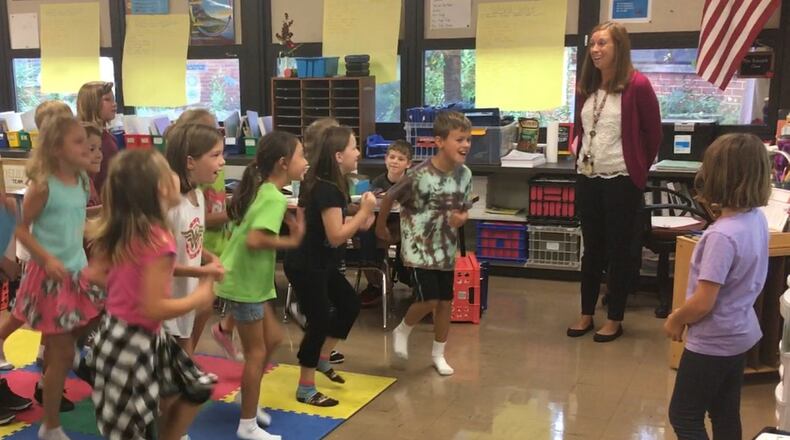“I see this plan as a document that we can all rally around as a framework, not a mandate … for all schools in this state to work as one to allow any child, no matter what scenario or circumstances they come from, to be whatever they want to be,” state school board member Nick Owens said. “That’s the American dream. … We see this as a plan that unites us all in a common purpose.”
The five-year plan — overwhelmingly approved last week — was developed via input from more than 1,200 Ohio educators, parents and others, after 13 public meetings around the state and work from five committees of professionals.
GRADUATION: Read bios of 2018 valedictorians from local schools
Peggy Lehner, chair of the Ohio Senate Education Committee, said for issues of racial/economic equity and social-emotional learning to “rise to the level of being a pillar” of the state’s education plan is a significant change.
Chad Wyen, superintendent of Mad River Local Schools, said the increased focus on social-emotional efforts is warranted.
“We have one of the highest rates of grandparents raising their grandchildren in the Dayton region, we touch one of the zip codes with the highest overdose rates in the country and … our economically disadvantaged population has pretty much doubled from 2002 (31.3%) to 2017 (62.1%),” Wyen said of the non-academic issues his educators face. “If we cannot meet the social-emotional needs of our learners, our students will not be prepared to focus on academics in the classroom.”
Key elements of plan
** Vision statement: It focuses on three verbs — challenging children to learn, preparing them for a post-graduation path, and empowering them to be resilient contributors to society.
** Goal: The plan says that every year, Ohio will increase the share of high school graduates who are in a successful spot one year after graduation — whether that means college, the military or a living-wage job.
** Three core principles: Quality schools are listed as a core principle, but so are the demands for equity (to make sure certain students aren't left behind), and partnerships (recognizing that learning goes far beyond the traditional classroom).
EDUCATION: Ohio bill calls for school to start after Labor Day
** Four domains (areas of focus): Two of the four are traditional academics. Under foundational skills, the state lists literacy, math and technology. And under well-rounded content are other subjects such as science and the arts. But "social-emotional learning" gets its own domain, encompassing relationship skills, responsible decision-making and other behavior-related items. The last domain is "leadership and reasoning," where the state highlights problem-solving, creativity and "information analytics."
How to implement
Lehner and Owens both said the new plan, while well-written, will not create change unless it is widely embraced by individual districts, schools and teachers. Lehner called that a “significant challenge,” and Owens said the state is planning a high-profile rollout of the plan around back-to-school time in August.
The plan lists 10 implementation strategies, including state-level efforts to increase teacher supply and training, making better high school connections between academic work and careers, as well as sharing a library of best practices on everything from early childhood literacy, to competency dealing with a variety of cultures.
EDUCATION: Local schools win $3 million-plus in reading grants
Two of the plan’s strategies suggest refining the report card system that Ohio uses for school accountability and de-emphasizing the importance of state standardized tests. The testing language says Ohio should “allow students to demonstrate competency and mastery” in ways beyond state tests.
Many of the strategies build on work already underway — Ohio’s Teacher Equity Plan addresses teacher supply, a state advisory group has been working on standards for social-emotional learning, and the state school board has been examining the state report card.
Money and politics
State Superintendent Paolo DeMaria said he believes the plan “promises a better and brighter future for all of Ohio’s children.” But the plan says ODE will need some restructuring to offer support, and Lehner said both state and local changes in focus will take time, as one size rarely fits all in education.
Wyen said he believes the plan is focused on the right work, but he argued the state “needs to fund us adequately” for local schools to provide necessary resources.
LAST MONTH: Softer graduation standards unlikely to be extended
“Time and money are certainly factors,” he said. “With all the accountability placed on districts and the stress of assessments and the report card, trying to blend addressing social-emotional needs while engaging students in the core content is a challenge.”
Lehner said despite the focus on equity, she is skeptical about this plan leading to increased funding for disadvantaged school districts. She called for greater scrutiny on the whether existing money is spent effectively. She said the ideas in the plan deserve statewide support.
“It’s incumbent on the legislature to appreciate the fact that this document was developed by educators, families, parents across the state, and take it seriously when we’re making our own plans,” Lehner said. “I think it would be unconscionable for the legislature to just walk away from the issues and goals that are identified here.”
About the Author

